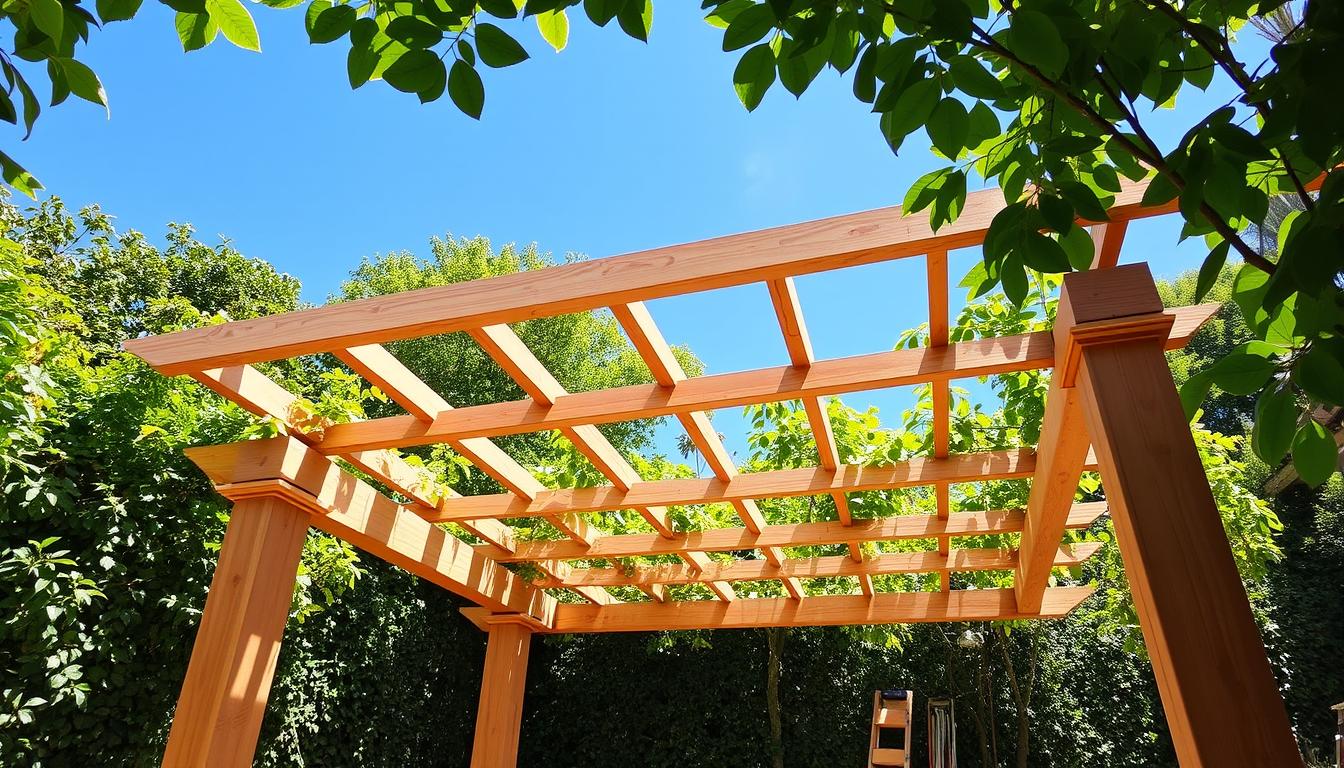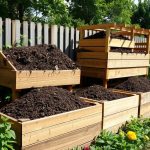Building a pergola is a fantastic way to enhance your backyard with both shade and style. It’s a rewarding DIY project that can transform your outdoor space. This article will walk you through the steps, from design to completion.
A well-crafted pergola offers the ideal shade for your patio or garden. It creates a welcoming area for relaxation and entertainment. Whether you aim to elevate your outdoor space’s elegance or seek sun protection, a pergola is an excellent choice. With the right tools and materials, you can create a pergola that suits your needs and boosts your outdoor enjoyment.
This article will cover the fundamentals of building a pergola, including design, planning, and construction. We’ll share tips and advice for crafting a beautiful, functional pergola that adds value to your home. Whether you’re an experienced DIYer or new to the scene, this guide will equip you with the knowledge to build a pergola that will be a joy for years.
Introduction to Pergola Building
Before we explore the specifics of pergola construction, let’s outline what this article will cover. We’ll discuss the importance of outdoor shade and how a pergola can be the perfect solution. We’ll also examine the various types of pergolas and the materials available for construction.
Key Takeaways
- Building a pergola can add outdoor shade and style to your backyard
- Pergola construction can be a fun and rewarding DIY project
- A well-designed pergola can provide the perfect outdoor shade for your patio or garden
- With the right tools and materials, you can build a pergola that meets your needs
- A pergola can enhance your outdoor living experience and add value to your home
- Pergola construction requires planning and attention to detail
- Outdoor shade is an important consideration when building a pergola
Understanding Pergola Design Basics
A well-designed pergola can transform your outdoor space. It offers shade, supports plants, and adds style to your backyard design. To begin, grasp the fundamentals of pergola design. This includes various styles, layouts, standard sizes, and material choices.
Pergolas can range from simple to complex, based on your preferences. Styles vary from attached to freestanding and gazebo-style. Select a design that complements your landscape and architecture for a cohesive look.
Common Pergola Styles and Layouts
- Attached pergolas: connected to a house or building
- Freestanding pergolas: standalone structures
- Gazebo-style pergolas: octagonal or circular designs
Material choice is also critical. Wooden structures are favored for their natural, rustic appeal. Other options include metal and vinyl, each with unique benefits and drawbacks.
Standard Pergola Dimensions
Typical pergolas measure 8-12 feet wide and 12-16 feet long. Yet, dimensions will vary based on your needs and available space in your backyard design.
Popular Material Options
Material selection hinges on durability, upkeep, and cost. Wooden structures need regular care to stay sturdy and appealing. In contrast, metal and vinyl pergolas are often easier to maintain and durable.
| Material | Advantages | Disadvantages |
|---|---|---|
| Wood | Natural look, rustic charm | Requires regular maintenance |
| Metal | Durable, low-maintenance | Can be expensive |
| Vinyl | Low-maintenance, affordable | May not be as sturdy as other options |
Essential Planning and Preparation Steps
Building a pergola requires proper planning for a successful and stress-free process. You must assess the site, determine the pergola’s purpose, and consider sunlight, wind, and rain. This careful planning ensures a beautiful, functional outdoor space that offers shade solutions and boosts your outdoor architecture.
To begin, focus on these critical factors:
- Site assessment: Evaluate the terrain, soil conditions, and surroundings to find the best spot for your pergola.
- Purpose: Define the pergola’s role, whether for shade, intimacy, or visual appeal in your outdoor area.
- Climate: Think about your local climate and weather to ensure your pergola can handle the elements.
By meticulously planning and preparing, you can craft a pergola that not only offers shade solutions but also complements your outdoor architecture. Take your time and weigh all factors that will influence your pergola’s design and functionality.
With thorough planning and attention to detail, you can build a breathtaking pergola. It will enhance your outdoor living space and provide enjoyment for years to come.
| Factor | Considerations |
|---|---|
| Site Assessment | Terrain, soil conditions, surrounding environment |
| Purpose | Shade, intimacy, visual interest |
| Climate | Local weather patterns, wind, rain, sunlight |
Required Tools and Materials for Pergola Building
Building a pergola requires the right tools and materials for success. You’ll need a mix of power tools and hand tools, along with quality materials like lumber, screws, and nails. It’s vital to pick materials that can handle the weather and support your outdoor area.
Make sure your tool list includes a circular saw, drill, and impact driver, plus hand tools like a hammer, tape measure, and level. Consider the type of lumber, such as pressure-treated or cedar, and how much you’ll need. A material quantity calculator can help figure out the exact amounts for your project.
Complete Tool Checklist
- Circular saw
- Drill
- Impact driver
- Hammer
- Tape measure
- Level
Material Quantity Calculator
Use an online material quantity calculator or get advice from a pro to get accurate measurements. This step helps avoid waste and ensures your pergola project goes smoothly.
Quality Considerations for Materials
When picking materials, focus on quality and durability. Choose items that resist rot, insects, and weather. Opt for a trusted supplier to guarantee top-notch products. With the right tools and materials, your pergola will be a beautiful addition to your outdoor space for many years.
Site Selection and Foundation Preparation
Building a pergola starts with choosing the right site and preparing the foundation. A flat and level site is key for a stable structure. It offers the perfect outdoor shade for relaxation and entertainment.
When preparing your site, consider the type of wooden structures and the soil conditions. Here are some factors to keep in mind:
- Clear the area of any debris or obstructions
- Check for any underground utilities or obstacles
- Mark out the area where your pergola will be built
By carefully selecting and preparing your site, you’ll build a sturdy pergola. It will provide the perfect
Foundation preparation is also crucial. This includes laying a foundation, like a concrete footing or a post anchor. It ensures a stable base for your wooden structures. Following these steps will help you create a beautiful and functional pergola. It will enhance your outdoor living space.
| Foundation Type | Description |
|---|---|
| Concrete Footing | A permanent foundation that provides a solid base for your pergola |
| Post Anchor | A type of foundation that uses anchors to secure the posts to the ground |
Creating a Strong Foundation Base
A well-designed backyard should include shade solutions for a comfortable outdoor space. Building a pergola requires a strong foundation base for stability and longevity. This means creating a level surface and securing posts with concrete footings and post anchors.
To achieve this, specific guidelines for concrete footing installation, post anchor placement, and surface leveling are crucial. Here are some key considerations:
- Concrete footings should be dug to a depth of at least 12 inches to provide a stable base for the pergola posts.
- Post anchors should be installed to secure the posts to the concrete footings, ensuring the structure remains level and secure.
- A level surface is critical to prevent the pergola from leaning or collapsing, so it’s essential to check the surface regularly during the installation process.
By following these guidelines and incorporating shade solutions into your backyard design, you can create a beautiful and functional outdoor living space. This space will provide comfort and relaxation for years to come.
Post Installation and Support Structure
In outdoor architecture, a strong support structure is key for garden structures like pergolas. Post installation is essential, laying the groundwork for the structure. Various post types exist, including wooden and metal, each with its own benefits and drawbacks.
The choice of post material significantly influences the look of garden structures. Wooden posts can bring warmth and coziness, while metal posts offer a modern, sleek appearance. It’s crucial to match the post material with the garden’s style and theme.
Here are some tips for installing posts securely:
- Choose the right post size and material for the pergola design
- Ensure the posts are level and plumb
- Use anchor kits to secure the posts to the ground
A well-designed support structure is vital for garden structures to withstand various weather conditions. By following these tips and considering the outdoor architecture and garden structures as a whole, you can create a beautiful and functional pergola that will last for years to come.
By incorporating these elements, you can create a stunning outdoor space that showcases your personal style and complements the surrounding garden structures.
| Post Material | Advantages | Disadvantages |
|---|---|---|
| Wooden | Warm and cozy appearance, easy to work with | Prone to rot and insect damage |
| Metal | Durable and low maintenance, modern look | Can be expensive, may rust over time |
Installing Main Support Beams
In pergola construction, the main support beams are vital for stability and safety. We’ll show you how to install these beams, focusing on accurate measurements and secure attachment.
First, figure out the right beam size and spacing for your pergola. This depends on its size, design, and the wooden structures used. Typically, beams are spaced 16-20 inches apart, but this can change based on your needs.
Beam Sizing and Spacing
- Measure your pergola’s width and length to find the needed beam length
- Pick the right beam size for the structure’s weight and stress
- Evenly space the beams, considering the pergola’s design and look
After deciding on beam size and spacing, attach them to the posts. This step is crucial in pergola construction for stability and safety. Use quality screws and brackets for attachment, ensuring beams are level and plumb.
Proper Attachment Methods
By following these steps and using the right materials, your pergola will be safe and sturdy. It will offer a beautiful outdoor living space for years. Always check local building codes and seek professional help if unsure about pergola construction.
Adding Decorative Elements and Finishing Touches
To enhance your pergola’s beauty and create a stunning outdoor shade feature in your backyard design, consider adding decorative elements and finishing touches. This can include trim and molding to give your pergola a polished look.
Some popular decorative elements for pergolas include:
- Carved wooden accents
- Wrought iron details
- Plants and vines
Finishing touches, such as a coat of stain or paint, can protect the pergola from the elements and enhance its appearance. Choose a color that complements your backyard design and provides a beautiful contrast to the surrounding landscape.
A well-designed pergola can be a stunning addition to any outdoor shade area, providing a sense of elegance and sophistication. By incorporating decorative elements and finishing touches, you can create a unique and inviting space that reflects your personal style.
Remember to consider the overall aesthetic you want to achieve with your backyard design when selecting decorative elements and finishing touches for your pergola. With a little creativity, you can create a beautiful and functional outdoor shade feature that enhances your outdoor living space.
| Decorative Element | Description |
|---|---|
| Trim and Molding | Adds a polished look to the pergola |
| Carved Wooden Accents | Provides a unique and elegant touch |
| Wrought Iron Details | Adds a touch of sophistication and elegance |
Weatherproofing Your Pergola Structure
To keep your pergola looking great and serving its purpose, protecting it from the weather is key. Weatherproofing is vital for your pergola’s longevity and durability. It ensures your pergola remains a reliable shade solution for many years.
Weatherproofing involves several important steps. Sealing and staining are among the most effective ways to shield your pergola. A waterproof sealant and stain can prevent damage from rain, sun, and snow. This keeps your pergola stable and secure.
Sealing and Staining Tips
- Choose a waterproof sealant that is designed for outdoor use
- Apply a stain that complements your pergola’s natural color
- Regularly check and maintain your pergola’s sealant and stain
Sealing and staining are just the beginning. Other methods include installing a roof or canopy, using weather-resistant materials, and regular cleaning. These steps help create a durable, long-lasting shade solution. It enhances your outdoor space, making it perfect for relaxation and entertainment.
Seasonal Maintenance Requirements
Regular upkeep is essential for a weatherproof and secure pergola. This includes checking for damage, cleaning, and making repairs as needed. By following seasonal maintenance, you can protect your pergola from the elements. This way, you can enjoy it for many years.
Enhancing Your Pergola with Lighting and Accessories
To elevate your pergola’s status in your garden, consider adding lighting and accessories. Options include string lights, lanterns, or other decorative pieces. These elements can significantly boost your outdoor space’s ambiance. When constructing your pergola, focus on the aesthetic you desire.
Popular lighting choices for your pergola include:
- String lights: These can be wrapped around the beams or hung from the roof, creating a warm ambiance.
- Lanterns: Placed on tables or hung from the structure, they add elegance to your garden.
Accessories like planters, decorative elements, or even a ceiling fan can also enhance your pergola. When planning, think about the accessories you want and how they’ll improve your garden’s look and feel.
With these finishing touches, you can craft a stunning pergola that complements your garden. It becomes a perfect retreat for enjoying the outdoors.
| Accessory | Description |
|---|---|
| String Lights | Add a warm and inviting glow to your pergola |
| Lanterns | Provide a touch of elegance to your garden structures |
| Planters | Add a pop of color and texture to your pergola |
Common Pergola Building Mistakes to Avoid
Building a pergola requires careful planning and attention to detail. It’s crucial to ensure the structure is sturdy and visually appealing, offering outdoor shade. A well-crafted pergola can elevate your garden or backyard’s beauty. On the other hand, a poorly constructed one can pose safety risks and diminish aesthetic appeal.
To sidestep common errors, thorough planning and the right choice of wooden structures are essential. Here are some critical mistakes to steer clear of:
- Structural issues: Make sure the pergola’s foundation is level and stable. Also, ensure the support beams are securely attached to the posts.
- Material selection errors: Opt for high-quality, weather-resistant materials that are suitable for outdoor use.
- Installation problems: Adhere to proper installation methods to avoid damaging the area or compromising the structure’s integrity.
Being mindful of these potential pitfalls can help you create a beautiful and functional pergola. It will provide outdoor shade and enhance your outdoor living space. Always choose durable wooden structures and follow best practices for a successful and stress-free construction process.
With meticulous planning and attention to detail, you can construct a stunning pergola. It will become the focal point of your garden or backyard, offering a comfortable and inviting space to relax and enjoy the outdoors.
| Mistake | Consequence | Solution |
|---|---|---|
| Structural issues | Collapsing or leaning pergola | Ensure level foundation and secure support beams |
| Material selection errors | Rotting or damaged wood | Choose high-quality, weather-resistant materials |
| Installation problems | Damage to surrounding area or structure | Follow proper installation techniques and consult professionals if needed |
Conclusion: Creating Your Perfect Outdoor Living Space
Building a pergola is a great way to change your backyard into a beautiful, functional space. This guide shows you how to make a stunning shade structure. It not only improves your backyard design but also offers a cool spot to escape the sun.
Imagine a cozy spot for relaxation or a lively area for parties. A well-made pergola can turn your dream into reality. With good planning, the right materials, and detail, you can make your outdoor living dream come true. Enjoy this versatile structure for many years.
So, don’t wait – start planning your pergola project today. This article gives you the knowledge and tools to create an amazing outdoor oasis. It will be the talk of the neighborhood.


